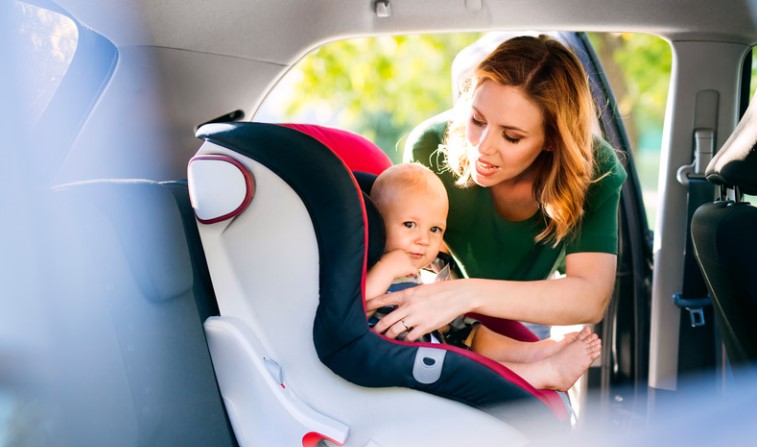As parents, we always want to ensure the safety of our children while travelling in a car. One common question is when can your child sit in the front seat? In Ontario, there are certain rules and regulations that must be followed to ensure your child’s safety.
Whether you’re planning a road trip or simply driving around town, it’s important to understand when it’s safe for your child to sit in the front seat. So let’s dive into everything you need to know about this topic!
When Can Child Sit in Front Seat in Ontario?
What are the Safety Rules for Children Sitting in the Front Seat?

Safety rules for children sitting in the front seat are crucial to minimize the risk of injury in case of an accident. Here are the key safety considerations and guidelines:
1. Age Consideration: It’s generally recommended that children under the age of 13 sit in the back seat. This is due to the potential dangers posed by airbags and the fact that the back seat is typically safer in the event of a crash.
2. Airbag Safety: Airbags are designed to protect adults in a collision, but they can be dangerous for children due to the force of deployment. If a child must sit in the front seat, ensure the airbag is turned off if the vehicle allows it. Additionally, move the front seat as far back as possible to increase the distance between the child and the airbag.
3. Proper Restraint: Regardless of where they sit, children should always use the appropriate restraint system:
- Rear-facing car seats for infants and toddlers until they reach the upper weight or height limit of the car seat.
- Forward-facing car seats for children who exceed rear-facing limits until they reach the seat’s maximum height and weight limit.
- Booster seats for children who outgrow their forward-facing car seats until they are big enough to use a seat belt safely.
- Seat belts should fit properly with the lap belt lying snugly across the upper thighs, not the stomach, and the shoulder belt should lie snug across the shoulder and chest, not across the neck or face.
4. Vehicle and Seat Adjustments: Adjust the vehicle seat to the proper position to ensure that seat belts and airbags (if active) can provide maximum protection. The seat should be adjusted to accommodate the child’s height, keeping the seatback upright.
5. Education on Safety: Teach children about the importance of sitting properly and remaining seated with their seatbelt securely fastened. Discourage rough play or changing positions while the vehicle is moving.
6. Follow Legal Requirements: Always adhere to the specific legal requirements regarding child restraint and front-seat occupancy in your jurisdiction. These laws are based on current safety research and are designed to provide the best possible protection in the event of an accident.
By following these rules, parents and guardians can significantly reduce the risks to children when they are in a vehicle. Always prioritize the safest seating arrangement to ensure that children are as protected as possible while traveling.
What Are the Age Restrictions According to Ontario Regulations?
In Ontario, the regulations regarding the age at which children can sit in the front seat of a vehicle are not strictly defined by age alone. Instead, Ontario’s laws focus on the proper use of car seats and booster seats based on a child’s weight and height, which indirectly influence the age at which it might be appropriate for a child to sit in the front seat.
Here’s a breakdown of Ontario’s regulations by child growth stages, which can give an indication of age:
- Rear-Facing Car Seats: Required until the child weighs at least 10 kg (22 lbs). Typically, this is for infants and toddlers from birth up to 2-3 years old.
- Forward-Facing Car Seats: Used once the child outgrows the rear-facing seat, typically when they weigh between 10 kg (22 lbs) and 18 kg (40 lbs). This stage usually covers from about 2 to 5 years old.
- Booster Seats: Required from the time the child outgrows the forward-facing seat until they are at least 145 cm (4 feet 9 inches) tall or between 8 and 12 years old.
- Seat Belts: Once children are tall enough (typically over 145 cm or 4 feet 9 inches) and mature enough to sit properly without a booster seat, they can use adult seat belts. This usually happens around the age of 8 to 12 years.
Although there is no explicit legal age for a child to sit in the front seat, the Ministry of Transportation of Ontario and safety experts recommend that children under the age of 13 are safest in the back seat.
This recommendation is based on the potential hazards associated with airbags and the generally greater protection offered by the rear seating area in vehicles during accidents.
Parents and guardians should also consider the specific guidance from their vehicle manufacturer regarding airbag deactivation and proper seat positioning if a child needs to sit in the front seat for any reason.
What Are the Guidelines for Properly Securing Your Child?

In Ontario, Canada, it is against the law to have a child under the age of 13 sit in the front seat of a vehicle. There are a few exceptions to this rule, such as if the car doesn’t have a back seat or if all other seats are occupied by children under the age of 13.
If you must have your child sit in the front seat, there are a few guidelines you should follow to ensure their safety:
- Ensure they are properly buckled up in a child safety seat appropriate for their weight and height
- If your car has airbags, make sure they are turned off. Airbags can be dangerous for small children and can cause serious injuries or even death
- Never allow your child to stand up or move around while the car is moving. They could easily be injured if something happens unexpectedly.
Benefits of Placing a Child in the Back Seat
Placing a child in the back seat of a vehicle is widely recommended by safety experts and regulatory agencies for several important reasons. Here are the key benefits of seating children in the back seat:
1. Enhanced Safety in Crashes
The back seat is generally the safest place in a vehicle during most types of crashes, particularly frontal collisions, which are the most common. The rear seats are typically further away from the impact zone and the front of the vehicle, reducing the risk of injury from the dashboard, windshield, or airbags.
2. Protection from Airbags
While airbags are lifesaving for adults, they can be extremely dangerous for children due to the force with which they deploy. Airbags are designed to protect adults whose bodies can withstand the impact, but children can be seriously injured or killed if they are struck by an airbag in the front seat.
3. Reduced Risk of Ejection
Children seated in the back are less likely to be ejected from a vehicle during a crash. Front seat passengers, especially those not properly restrained, have a higher risk of being thrown through the front windshield.
4. Mitigation of Debris and Intrusion
In the event of a vehicle collision, the front section of the car often sustains more deformation and intrusion from the crash impact than the rear part. Children in the back seat are further from potential points of intrusion and flying debris, which can result in severe injuries.
5. Less Accessible to Common Hazards
Children in the back seat are less likely to access potentially dangerous car controls, such as gear shifters, steering wheels, or other instruments and buttons that could cause distractions or unintentional operation by curious hands.
6. Psychological Benefits
Being in the back seat can help instill a routine and understanding in children that the back is their space, designed for their safety. This can help reduce the desire to sit in the front seat until they are old enough and large enough to do so safely.
7. Social Interaction and Monitoring
For families with multiple children, having all kids in the back can facilitate easier interaction among them, potentially leading to a more engaging ride. Additionally, parents can use mirrors to keep an eye on younger children, making it easier to monitor their safety throughout the journey.
8. Compliance with Laws
Many regions have specific laws mandating that children of certain ages or sizes ride in the back seat. Compliance with these laws not only enhances safety but also avoids legal penalties.
Penalties for Failing to Follow Child Car Safety Requirements

In Ontario, failing to follow child car safety requirements can result in several penalties, as the law takes the safety of children in vehicles very seriously. Here are the main penalties and consequences that drivers can face if they do not adhere to the legal requirements for child passenger safety:
1. Fines
Drivers who fail to properly secure children in an appropriate car seat or booster seat can be fined. In Ontario, the fines for these offenses can range from $200 to $1,000. This range includes the set fine and the additional costs such as court fees and victim fine surcharges.
2. Demerit Points
Along with financial penalties, drivers can also receive demerit points on their driving record for failing to properly secure a child. In Ontario, not properly using a child car seat or seat belt system can result in 2 demerit points being added to the driver’s record.
3. Increased Insurance Rates
Accumulation of fines and demerit points can lead to higher car insurance rates. Insurance companies view non-compliance with safety regulations as increased risk, which can lead to increased premiums for the driver.
4. Vehicle Impoundment
In severe cases, particularly where non-compliance with child safety regulations is part of a broader pattern of unsafe driving, authorities may impound the vehicle.
5. Legal Consequences
In cases of an accident where a child was not properly secured, the driver may face more severe legal consequences, including charges such as reckless or dangerous driving. If the child is injured or killed, the driver could face serious charges such as criminal negligence or endangerment.
Conclusion
In Ontario, the law requires that children under the age of 13 must ride in a rear seat. If no suitable seating is available in the back, an appropriate child restraint system must be used for any child between 9 and 18 kg.
Children over 18 kg may sit in either a booster seat or use a lap belt if they are tall enough to do so without assistance. It’s important for parents to ensure their children are properly restrained at all times when travelling in vehicles, as this can make all the difference should an accident occur.
FAQs – When Can Child Sit in Front Seat in Ontario?

How much does a child have to weigh to sit in the front seat in Ontario?
In Ontario, a child has to weigh at least 80 lbs (36 kg) to sit in the front seat. If the child doesn’t weigh enough, they must sit in the back seat.
Can a 7-year-old sit in the front seat near Toronto?
According to the Ontario Highway Traffic Act, a child under the age of 8 must be properly secured in a car seat or booster seat appropriate for their height and weight. They must also be seated in the back seat of the vehicle.
If all of the back seats are occupied by other children under the age of 13, then the child may be seated in the front seat. However, the front airbag must be turned off for them to ride there safely.
How tall do you have to be to sit in the front seat in Canada?
In Canada, the legal height to sit in the front seat of a car is 145 cm (4’9″). If your child is under this height, they must sit in the back seat. There are a few exceptions to this Ontarian rule:
- If all other seats in the vehicle are occupied by children under the age of 12
- If the vehicle only has only two seats available
- If the vehicle does not have a passenger-side airbag
- If you are travelling in a taxi or other commercial vehicle
Is it illegal to have 6 passengers in a 5-passenger car in Ontario?
In Ontario, the Highway Traffic Act (HTA) does not prohibit having more than five people in a car. There are certain exceptions to the rule, though. For example, if you are transporting children under the age of 13, you can have up to seven people in your vehicle.
In addition, if you are driving a van or SUV that is designed to seat more than seven people, you can have up to 10 people in your vehicle.
So, while it is not illegal to have six passengers in a five-passenger car in Ontario, there are some circumstances where it is not recommended. If you have any questions about the HTA or how it applies to your situation, contact a local police officer or licensed legal professional for guidance.
Does my 8-year-old need a booster seat in Ontario?
In Ontario, children under the age of 8 must be properly restrained in a booster seat or car seat that is appropriate for their height and weight. If your child is over eight years old but less than 145 cm (4 feet 9 inches) tall, they must use a booster seat.
Booster seats help to position the seat belt correctly so it fits properly over the child’s shoulder and hip bones.
You can tell if a seat belt fits properly if:
- Instead of crossing the neck, the shoulder strap rests over the middle of the chest and shoulder
- The lap part of the belt is low across the hips and upper thighs, not the stomach
For children who have outgrown their booster seats but are still under 145 cm tall, it’s important to ensure they continue using a lap and shoulder seat belt.










